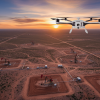The further forward we go, the further back we have to explore in order to go forward again. ~~ Stephen Gardiner
The successes of the autonomous drone industry in the previous decade planted the seeds of what promises to be another astonishing decade. In the spirit of Stephen Gardiner, a renowned architect and author, it’s always worth taking a look at what we’ve accomplished as an industry and a company. But it’s even more worthwhile drilling down into what we’re going to accomplish.
2019 – A Memorable Year for Autonomous Drone Flight
The autonomous drone industry took a giant leap forward in March of 2019 when a Percepto drone made the first autonomous drone flight over a 5G network. This came about as a result of our close collaboration with SK Telecom, the largest mobile operator in the Republic of Korea. And it laid important foundations for the wider adoption of autonomous drones, as more countries roll out their own next generation mobile networks and can reap the benefits of high-resolution video in real-time.
Percepto also pushed the boundaries of the autonomous drone industry with a number of technological breakthroughs in 2019. We launched the next-generation of our AI-powered autonomous industrial Drone-in-a-Box (DIB), which is already flying operationally in a wide range of weather conditions – from the hot and humid air of Mexico to the frigid and snowy Midwestern US. Our newest solution boasts seamless integration of 2D mapping and 3D modeling for the autonomous creation of valuable data assets, and also automatically generates reports with both in real-time and post-mission insights – facilitating true data-driven decision making. With safety always a top priority, we also recently added a built-in safety parachute for the drone.
These innovations did not go unrecognized. We were thrilled to see Percepto ranked in the 20 most promising drone technology solution providers of the year by CIO Review, as well as shortlisted for the prestigious Security Technology Innovation of the Year Award. Customers noticed, too. In 2019, we dramatically expanded our industrial footprint into diverse sectors across four continents and ten countries – providing aerial insights that improve operations, maintenance, safety, security and regulatory compliance for companies in mining, oil & gas, solar and thermoelectric power.
We also saw serious progress this year in what has long been a major impediment to the industrial drone market: regulation. By working collaboratively with end-user organizations and regulators in the past year, we received Beyond Visual Line of Sight (BVLOS) waivers in various countries including the US, Mexico, Singapore, Portugal Israel, and Italy – and we expect to obtain many more in the coming years.
Finally, in 2019 the market potential for industrial drone technology did not escape the attention of the investor community, and we saw numerous multi-million dollar investments. One such announcement was in May, when Percepto closed $15M Series A round of funding, led by USVP with participation from NHN, Spider Capital and Emerge.
2021 and Beyond – The Future of Autonomous Drone Flight
Investment bank Goldman Sachs predicts the global drone industry will be worth $100 billion within the next 12 months. Other analysts predict drones and drone-related technologies will contribute some $82 billion to the US economy alone by 2025 and create some 100,000 new jobs. In 2020 and beyond, the quantum leap the drone industry is going to experience will be facilitated through a combination of innovation, investment in infrastructure and regulatory change.
- Regulatory Tipping Point
Possibly the most significant development we expect in 2020 and beyond will be in the regulatory arena. This year will be the tipping point, especially in the US, where the Federal Aviation Authority (FAA) has signaled a landmark shift towards blanket approval for tested systems. With the FAA and other agencies like the Civil Aviation Safety Authority (CASA) in Australia moving from a waiver per site approach to a company-wide/system-based approval process, regulatory hurdles are diminishing. This alone has the potential to encourage organizations to accelerate their drone deployment strategies.
- Unmanned Traffic Management Systems (UTM)
More drones mean busier skies, necessitating Unmanned Traffic Management (UTM), especially in congested urban environments where BVLoS delivery drones will operate with greater frequency. Advanced UTM systems take an approach similar to that being developed for autonomous vehicles on our roads – whereby the speed and position of each vehicle is constantly shared with the system. A beta UTM system was launched in 2019, a prototype UTM system is slated to be built in Japan in early 2020, and many other countries are working on their UTMs as well.
- Masses of Data Require AI-Powered Analysis
Another springboard for the autonomous drone industry will be the implementation of AI-powered analysis tools. With autonomous drone solutions able to make multiple flights daily, the volume of visual data they collect is immense. In order to harness this data and glean the insights that can impact many levels of an organization, more powerful analysis tools are required. Already we’re seeing powerful artificial intelligence and machine learning being applied to drone-generated data, and advances in this field will continue throughout 2020.
- 5G Networks
Finally, the continuing rollout of 5G networks will fundamentally change the way we access and use drone-generated data and visuals. The impact of these next generation mobile networks on the adoption and application of autonomous drone technology (as well as other autonomous vehicles) cannot be overstated. The improvements in speed are game-changing compared to even the fastest 4G available. For example, Verizon is suggesting peak data rates of 10 gigabits per second across its 5G Ultra Wideband network.
Our own testing with SKT demonstrated that autonomous flights over 5G networks deliver numerous operational advantages, such as better real-time video stream quality and reduced battery consumption. This means drones will be able to stay in the air for longer and travel farther; process more data, more quickly; and relay more powerful insights back faster.
The Bottom Line
2019 was a watershed year in the autonomous drone industry, and there’s every indication that 2020 and beyond will see greater technological advancement, wider adoption, smarter regulation, and more powerful analysis capabilities. At Percepto, we’re looking forward to the future where the sky is truly the limit!





